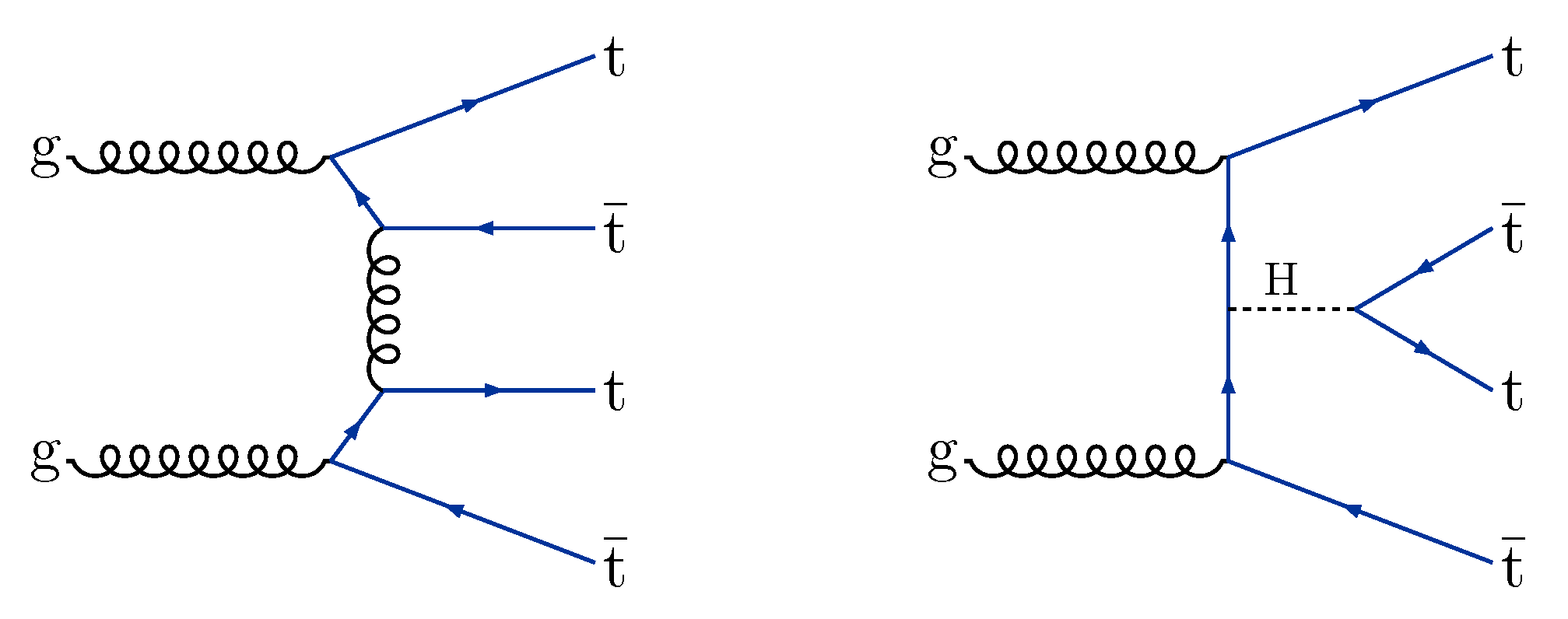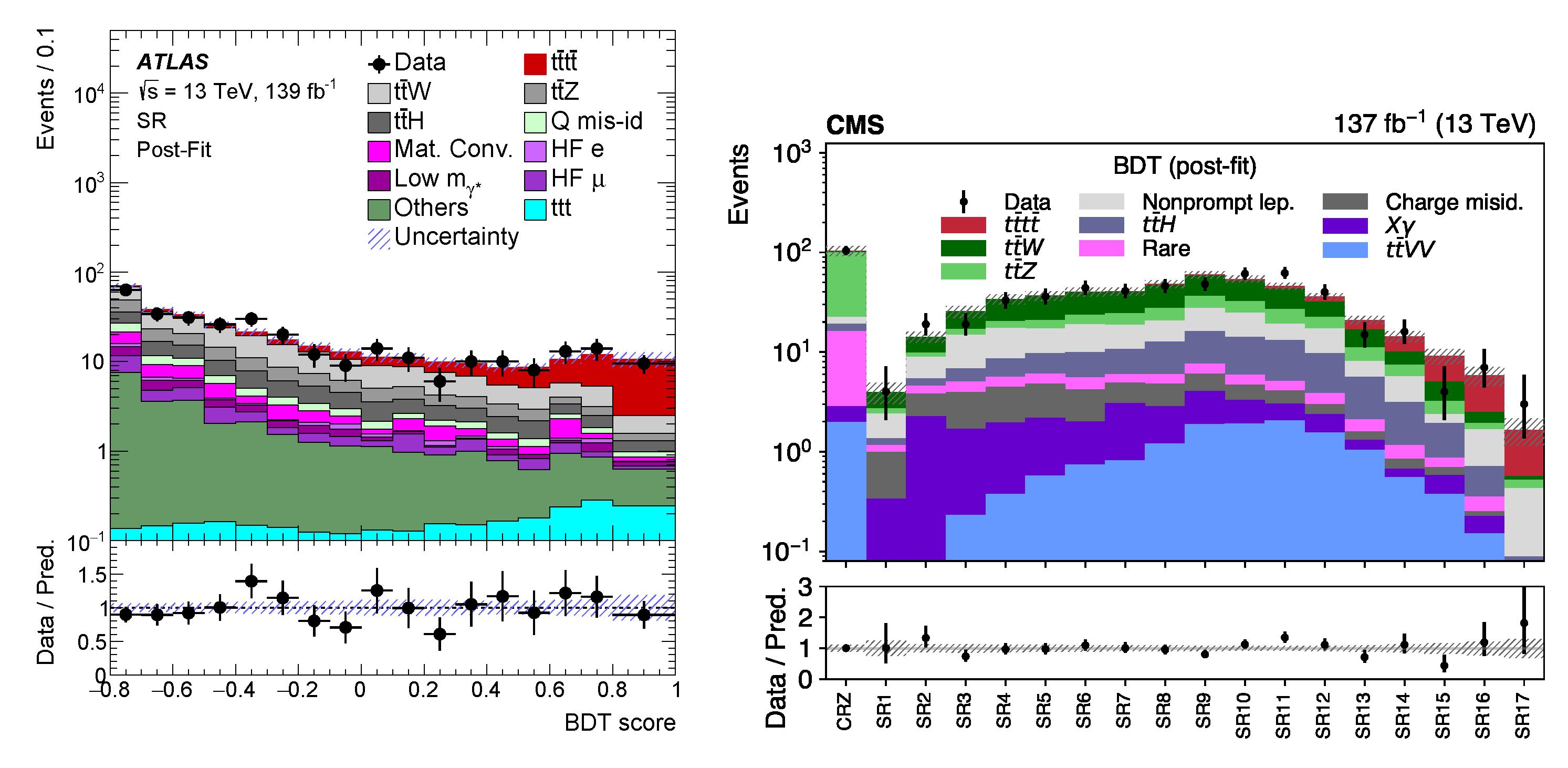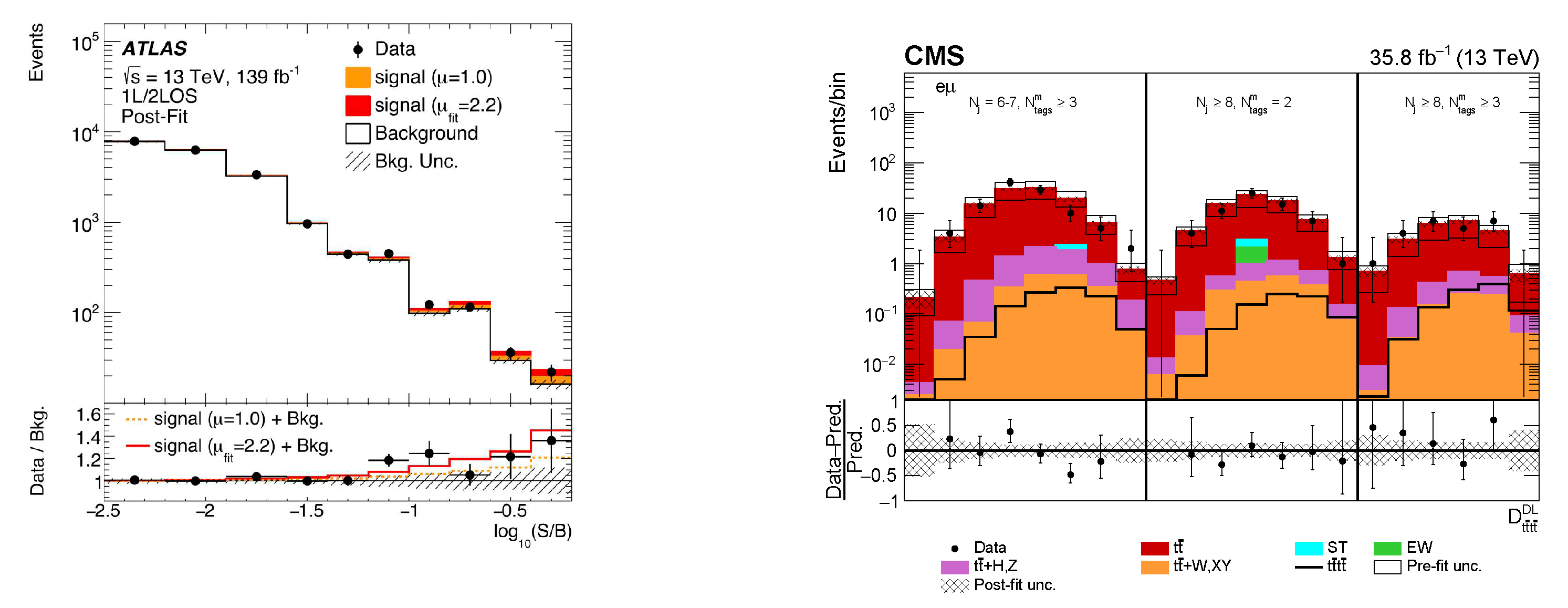Four-top quark physics at the LHC
Abstract
1. Introduction
2. Current Status of Four-Top Quark Measurements
2.1. Searches for Production in Same-Charge Dilepton and Multi-Lepton Final States
2.1.1. Event Selection and Backgrounds
2.1.2. Signal Extraction and Results
2.2. Searches for Production in Single-Lepton and Opposite-Charge Dilepton Final States
2.2.1. Event Selection and Backgrounds
2.2.2. Signal Extraction and Results
2.3. Search for Production in the All-Hadronic Final State
2.3.1. Event Selection and Backgrounds
2.3.2. Signal Extraction and Results
2.3.3. CMS Run 2 Combination
3. Interpretations
3.1. Yukawa Coupling
3.2. EFTs
3.3. BSM Sensitivity
4. Future of Four-Top Quark Measurements
Opportunities
5. Conclusions
Funding
Acknowledgments
Conflicts of Interest
References
- CDF Collaboration. Observation of top quark production in p collisions. Phys. Rev. Lett. 1995, 74, 2626. [Google Scholar] [CrossRef]
- D0 Collaboration. Observation of the top quark. Phys. Rev. Lett. 1995, 74, 2632. [Google Scholar] [CrossRef] [PubMed]
- ATLAS, CMS Collaboration. Combination of inclusive top-quark pair production cross-section measurements using ATLAS and CMS data at =7 and 8 TeV. arXiv 2022, arXiv:2205.13830. [Google Scholar]
- ATLAS Collaboration. Measurement of the t production cross-section in the lepton+jets channel at = 13 TeV with the ATLAS experiment. Phys. Lett. B 2020, 810, 135797. [Google Scholar] [CrossRef]
- ATLAS Collaboration. Measurement of the t production cross-section and lepton differential distributions in eμ dilepton events from pp collisions at = 13 TeV with the ATLAS detector. Eur. Phys. J. C 2020, 80, 528. [Google Scholar] [CrossRef]
- CMS Collaboration. Measurement of the t production cross section using events with one lepton and at least one jet in pp collisions at = 13 TeV. J. High Energy Phys. 2017, 9, 51. [Google Scholar] [CrossRef]
- CMS Collaboration. Measurement of the t production cross section using events in the eμ final state in pp collisions at = 13 TeV. Eur. Phys. J. C 2017, 77, 172. [Google Scholar] [CrossRef]
- D0 Collaboration. Observation of Single Top Quark Production. Phys. Rev. Lett. 2009, 103, 92001. [Google Scholar] [CrossRef]
- CDF Collaboration. First Observation of Electroweak Single Top Quark Production. Phys. Rev. Lett. 2009, 103, 92002. [Google Scholar] [CrossRef]
- ATLAS, CMS Collaboration. Combinations of single-top-quark production cross-section measurements and |fLVVtb| determinations at = 7 and 8 TeV with the ATLAS and CMS experiments. J. High Energy Phys. 2019, 5, 88. [Google Scholar] [CrossRef]
- ATLAS Collaboration. Measurement of the inclusive cross-sections of single top-quark and top-antiquark t-channel production in pp collisions at = 13 TeV with the ATLAS detector. J. High Energy Phys. 2017, 4, 86. [Google Scholar] [CrossRef]
- ATLAS Collaboration. Measurement of the cross-section for producing a W boson in association with a single top quark in pp collisions at = 13 TeV with ATLAS. J. High Energy Phys. 2018, 1, 63. [Google Scholar] [CrossRef]
- CMS Collaboration. Measurement of the single top quark and antiquark production cross sections in the t channel and their ratio in proton-proton collisions at = 13 TeV. Phys. Lett. B 2020, 800, 135042. [Google Scholar] [CrossRef]
- CMS Collaboration. Measurement of the production cross section for single top quarks in association with W bosons in proton-proton collisions at = 13 TeV. J. High Energy Phys. 2018, 10, 117. [Google Scholar] [CrossRef]
- Frederix, R.; Pagani, D.; Zaro, M. Large NLO corrections in tW± and tt hadroproduction from supposedly subleading EW contributions. J. High Energy Phys. 2018, 2, 31. [Google Scholar] [CrossRef]
- Bevilacqua, G.; Worek, M. Constraining BSM Physics at the LHC: Four top final states with NLO accuracy in perturbative QCD. J. High Energy Phys. 2012, 7, 111. [Google Scholar] [CrossRef]
- Alwall, J.; Frederix, R.; Frixione, S.; Hirschi, V.; Maltoni, F.; Mattelaer, O.; Shao, H.S.; Stelzer, T.; Torrielli, P.; Zaro, M. The automated computation of tree-level and next-to-leading order differential cross sections, and their matching to parton shower simulations. J. High Energy Phys. 2014, 7, 79. [Google Scholar] [CrossRef]
- Maltoni, F.; Pagani, D.; Tsinikos, I. Associated production of a top-quark pair with vector bosons at NLO in QCD: Impact on tH searches at the LHC. J. High Energy Phys. 2016, 2, 113. [Google Scholar] [CrossRef]
- Frederix, R.; Frixione, S.; Hirschi, V.; Pagani, D.; Shao, H.S.; Zaro, M. The automation of next-to-leading order electroweak calculations. J. High Energy Phys. 2018, 7, 185. [Google Scholar] [CrossRef]
- Ježo, T.; Kraus, M. Hadroproduction of four top quarks in the powheg box. Phys. Rev. D 2022, 105, 114024. [Google Scholar] [CrossRef]
- Sjostrand, T.; Mrenna, S.; Skands, P.Z. A Brief Introduction to PYTHIA 8.1. Comput. Phys. Commun. 2008, 178, 852. [Google Scholar] [CrossRef]
- ATLAS Collaboration. Evidence for tt production in the multilepton final state in proton–proton collisions at = 13 TeV with the ATLAS detector. Eur. Phys. J. C 2020, 80, 1085. [Google Scholar] [CrossRef]
- Apollinari, G.; Béjar Alonso, I.; Brüning, O.; Lamont, M.; Rossi, L. High-Luminosity Large Hadron Collider (HL-LHC): Preliminary Design Report. CERN Yellow Rep. Monogr. 2015, 5, 285. [Google Scholar] [CrossRef]
- Azzi, P. Report from Working Group 1: Standard Model Physics at the HL-LHC and HE-LHC. CERN Yellow Rep. Monogr. 2019, 7, 1–220. [Google Scholar] [CrossRef]
- FCC Collaboration. FCC-hh: The Hadron Collider: Future Circular Collider Conceptual Design Report Volume 3. Eur. Phys. J. ST 2019, 228, 755. [Google Scholar] [CrossRef]
- CMS Collaboration. Search for production of four top quarks in final states with same-sign or multiple leptons in proton-proton collisions at = 13 TeV. Eur. Phys. J. C 2020, 80, 75. [Google Scholar] [CrossRef]
- ATLAS Collaboration. Measurement of the tt production cross section in pp collisions at = 13 TeV with the ATLAS detector. J. High Energy Phys. 2021, 11, 118. [Google Scholar] [CrossRef]
- CMS Collaboration. Search for the production of four top quarks in the single-lepton and opposite-sign dilepton final states in proton-proton collisions at = 13 TeV. J. High Energy Phys. 2019, 11, 82. [Google Scholar] [CrossRef]
- Frederix, R.; Tsinikos, I. Subleading EW corrections and spin-correlation effects in tW multi-lepton signatures. Eur. Phys. J. C 2020, 80, 803. [Google Scholar] [CrossRef]
- Broggio, A.; Ferroglia, A.; Frederix, R.; Pagani, D.; Pecjak, B.D.; Tsinikos, I. Top-quark pair hadroproduction in association with a heavy boson at NLO+NNLL including EW corrections. J. High Energy Phys. 2019, 8, 39. [Google Scholar] [CrossRef]
- Kulesza, A.; Motyka, L.; Schwartländer, D.; Stebel, T.; Theeuwes, V. Associated top quark pair production with a heavy boson: Differential cross sections at NLO + NNLL accuracy. Eur. Phys. J. C 2020, 80, 428. [Google Scholar] [CrossRef]
- von Buddenbrock, S.; Ruiz, R.; Mellado, B. Anatomy of inclusive tW production at hadron colliders. Phys. Lett. B 2020, 811, 135964. [Google Scholar] [CrossRef]
- Cordero, F.F.; Kraus, M.; Reina, L. Top-quark pair production in association with a W± gauge boson in the POWHEG-BOX. Phys. Rev. D 2021, 103, 94014. [Google Scholar] [CrossRef]
- Bevilacqua, G.; Bi, H.Y.; Cordero, F.F.; Hartanto, H.B.; Kraus, M.; Nasufi, J.; Reina, L.; Worek, M. Modeling uncertainties of tW± multilepton signatures. Phys. Rev. D 2022, 105, 14018. [Google Scholar] [CrossRef]
- Denner, A.; Pelliccioli, G. Combined NLO EW and QCD corrections to off-shell tW production at the LHC. Eur. Phys. J. C 2021, 81, 354. [Google Scholar] [CrossRef]
- ATLAS Collaboration. Analysis of tH and tW Production in Multilepton Final States with the ATLAS Detector; ATLAS Conference Note ATLAS-CONF-2019-045; 2019. [Google Scholar]
- CMS Collaboration. Measurements of t cross sections in association with b jets and inclusive jets and their ratio using dilepton final states in pp collisions at = 13 TeV. Phys. Lett. B 2018, 776, 355–378. [Google Scholar] [CrossRef]
- CMS Collaboration. Search for new physics in same-sign dilepton events in proton–proton collisions at = 13 TeV. Eur. Phys. J. C 2016, 76, 439. [Google Scholar] [CrossRef]
- ATLAS Collaboration. ATLAS b-jet identification performance and efficiency measurement with t events in pp collisions at = 13 TeV. Eur. Phys. J. C 2019, 79, 970. [Google Scholar] [CrossRef]
- CMS Collaboration. Evidence for the simultaneous production of four top quarks in proton-proton collisions at = 13 TeV, CMS Physics Analysis Summary CMS-PAS-TOP-21-005. 2022. [Google Scholar]
- CMS Collaboration. Machine learning-based identification of highly Lorentz-boosted hadronically decaying particles at the CMS experiment, CMS Physics Analysis Summary CMS-PAS-JME-18-002. 2019. [Google Scholar]
- Choi, S.; Oh, H. Improved extrapolation methods of data-driven background estimations in high energy physics. Eur. Phys. J. C 2021, 81, 643. [Google Scholar] [CrossRef]
- Choi, S.; Lim, J.; Oh, H. Data-driven Estimation of Background Distribution through Neural Autoregressive Flows. arXiv 2020, arXiv:2008.03636. [Google Scholar]
- Cao, Q.-H.; Chen, S.-L.; Liu, Y. Probing Higgs Width and Top Quark Yukawa Coupling from tH and tt Productions. Phys. Rev. D 2017, 95, 53004. [Google Scholar] [CrossRef]
- Cao, Q.-H.; Chen, S.-L.; Liu, Y.; Zhang, R.; Zhang, Y. Limiting top quark-Higgs boson interaction and Higgs-boson width from multitop productions. Phys. Rev. D 2019, 99, 113003. [Google Scholar] [CrossRef]
- CMS Collaboration. Measurement of the top quark Yukawa coupling from t kinematic distributions in the dilepton final state in proton-proton collisions at = 13 TeV. Phys. Rev. D 2020, 102, 92013. [Google Scholar] [CrossRef]
- CMS Collaboration. Measurement of the top quark Yukawa coupling from t kinematic distributions in the lepton+jets final state in proton-proton collisions at = 13 TeV. Phys. Rev. D 2019, 100, 72007. [Google Scholar] [CrossRef]
- CMS Collaboration. Measurement of the Higgs boson production rate in association with top quarks in final states with electrons, muons, and hadronically decaying tau leptons at = 13 TeV. Eur. Phys. J. C 2021, 81, 378. [Google Scholar] [CrossRef]
- Hartland, N.P.; Maltoni, F.; Nocera, E.R.; Rojo, J.; Slade, E.; Vryonidou, E.; Zhang, C. A Monte Carlo global analysis of the Standard Model Effective Field Theory: The top quark sector. J. High Energy Phys. 2019, 4, 100. [Google Scholar] [CrossRef]
- D’Hondt, J.; Mariotti, A.; Mimasu, K.; Moortgat, S.; Zhang, C. Learning to pinpoint effective operators at the LHC: A study of the tb signature. J. High Energy Phys. 2018, 11, 131. [Google Scholar] [CrossRef]
- ATLAS Collaboration. Search for four-top-quark production in the single-lepton and opposite-sign dilepton final states in pp collisions at = 13 TeV with the ATLAS detector. Phys. Rev. D 2019, 99, 52009. [Google Scholar] [CrossRef]
- Degrande, C.; Gerard, J.-M.; Grojean, C.; Maltoni, F.; Servant, G. Non-resonant New Physics in Top Pair Production at Hadron Colliders. J. High Energy Phys. 2011, 3, 125. [Google Scholar] [CrossRef]
- Englert, C.; Giudice, G.F.; Greljo, A.; Mccullough, M. The -Parameter: An Oblique Higgs View. J. High Energy Phys. 2019, 9, 41. [Google Scholar] [CrossRef]
- ATLAS Collaboration. Combined measurements of Higgs boson production and decay using up to 80 fb−1 of proton-proton collision data at = 13 TeV collected with the ATLAS experiment. Phys. Rev. D 2020, 101, 12002. [Google Scholar] [CrossRef]
- Brehmer, J.; Cranmer, K.; Louppe, G.; Pavez, J. A Guide to Constraining Effective Field Theories with Machine Learning. Phys. Rev. D 2018, 98, 52004. [Google Scholar] [CrossRef]
- CMS Collaboration. Probing effective field theory operators in the associated production of top quarks with a Z boson in multilepton final states at = 13 TeV. J. High Energy Phys. 2021, 12, 83. [Google Scholar] [CrossRef]
- Dicus, D.; Stange, A.; Willenbrock, S. Higgs decay to top quarks at hadron colliders. Phys. Lett. B 1994, 333, 126–131. [Google Scholar] [CrossRef]
- Craig, N.; D’Eramo, F.; Draper, P.; Thomas, S.; Zhang, H. The Hunt for the Rest of the Higgs Bosons. J. High Energy Phys. 2015, 6, 137. [Google Scholar] [CrossRef]
- Craig, N.; Hajer, J.; Li, Y.-Y.; Liu, T.; Zhang, H. Heavy Higgs bosons at low tanβ: From the LHC to 100 TeV. J. High Energy Phys. 2017, 1, 18. [Google Scholar] [CrossRef]
- Boveia, A.; Shepherd, W.; D’Eramo, F.; Worm, S.; du Pree, T.; Salek, D.; Wang, L.T.; De Simone, A.; Zurek, K.; Khoze, V.V.; et al. Recommendations on presenting LHC searches for missing transverse energy signals using simplified s-channel models of dark matter. Phys. Dark Univ. 2020, 27, 100365. [Google Scholar] [CrossRef]
- Albert, A.; et al.; [LHC Dark Matter Working Group] Recommendations of the LHC Dark Matter Working Group: Comparing LHC searches for dark matter mediators in visible and invisible decay channels and calculations of the thermal relic density. Phys. Dark Univ. 2019, 26, 100377. [Google Scholar] [CrossRef]
- Alvarez, E.; Faroughy, D.A.; Kamenik, J.F.; Morales, R.; Szynkman, A. Four Tops for LHC. Nucl. Phys. B 2017, 915, 19. [Google Scholar] [CrossRef]
- Ramond, P. Dual theory for free fermions. Phys. Rev. D 1971, 3, 2415. [Google Scholar] [CrossRef]
- Gol’fand, Y.A.; Likhtman, E.P. Extension of the algebra of Poincaré group generators and violation of P invariance. JETP Lett. 1971, 13, 323. [Google Scholar]
- Neveu, A.; Schwarz, J.H. Factorizable dual model of pions. Nucl. Phys. B 1971, 31, 86. [Google Scholar] [CrossRef]
- Volkov, D.V.; Akulov, V.P. Possible universal neutrino interaction. JETP Lett. 1972, 16, 438. [Google Scholar]
- Wess, J.; Zumino, B. A Lagrangian model invariant under supergauge transformations. Phys. Lett. B 1974, 49, 52–54. [Google Scholar] [CrossRef]
- Wess, J.; Zumino, B. Supergauge transformations in four dimensions. Nucl. Phys. B 1974, 70, 39. [Google Scholar] [CrossRef]
- Fayet, P. Supergauge invariant extension of the Higgs mechanism and a model for the electron and its neutrino. Nucl. Phys. B 1975, 90, 104. [Google Scholar] [CrossRef]
- Nilles, H.P. Supersymmetry, supergravity and particle physics. Phys. Rep. 1984, 110, 1–162. [Google Scholar] [CrossRef]
- Martin, S.P. A Supersymmetry primer. Adv. Ser. Direct. High Energy Phys. 1998, 18, 1–153. [Google Scholar] [CrossRef]
- Farrar, G.R.; Fayet, P. Phenomenology of the Production, Decay, and Detection of New Hadronic States Associated with Supersymmetry. Phys. Lett. B 1978, 76, 575–579. [Google Scholar] [CrossRef]
- ATLAS Collaboration. Search for new phenomena in final states with large jet multiplicities and missing transverse momentum using = 13 TeV proton-proton collisions recorded by ATLAS in Run 2 of the LHC. J. High Energy Phys. 2020, 10, 62. [Google Scholar] [CrossRef]
- CMS Collaboration. Searches for physics beyond the standard model with the MT2 variable in hadronic final states with and without disappearing tracks in proton-proton collisions at = 13 TeV. Eur. Phys. J. C 2020, 80, 3. [Google Scholar] [CrossRef] [PubMed]
- CMS Collaboration. Search for supersymmetry in proton-proton collisions at 13 TeV in final states with jets and missing transverse momentum. J. High Energy Phys. 2019, 10, 244. [Google Scholar] [CrossRef]
- CMS Collaboration. Search for supersymmetry in pp collisions at = 13 TeV with 137 fb−1 in final states with a single lepton using the sum of masses of large-radius jets. Phys. Rev. D 2020, 101, 52010. [Google Scholar] [CrossRef]
- Bauer, M.; Haisch, U.; Kahlhoefer, F. Simplified dark matter models with two Higgs doublets: I. Pseudoscalar mediators. J. High Energy Phys. 2017, 5, 138. [Google Scholar] [CrossRef]
- LHC Dark Matter Working Group. LHC Dark Matter Working Group: Next-generation spin-0 dark matter models. Phys. Dark Univ. 2020, 27, 100351. [Google Scholar] [CrossRef]
- Darmé, L.; Fuks, B.; Goodsell, M. Cornering sgluons with four-top-quark events. Phys. Lett. B 2018, 784, 223–228. [Google Scholar] [CrossRef]
- CMS Collaboration. Search for standard model production of four top quarks with same-sign and multilepton final states in proton–proton collisions at = 13 TeV. Eur. Phys. J. C 2018, 78, 140. [Google Scholar] [CrossRef]
- ATLAS Collaboration. Physics at a 100 TeV pp Collider: Standard Model Processes. In HL-LHC Prospects for the Measurement of the Standard Model Four-Top-Quark Production Cross-Section; ATLAS Conference Note ATL-PHYS-PUB-2018-047; 2018. [Google Scholar]
- ATLAS Collaboration. HL-LHC Prospects for the Measurement of the Standard Model Four-Top-Quark Production Cross-Section; ATLAS Conference Note ATL-PHYS-PUB-2018-047; 2018. [Google Scholar]
- CMS Collaboration. Projections of sensitivities for tttt production at HL-LHC and HE-LHC, CMS Physics Analysis Summary CMS-PAS-FTR-18-031. 2018. [Google Scholar]
- ATLAS Collaboration. Extrapolation of ATLAS sensitivity to the measurement of the Standard Model four top quark cross section at the HL-LHC, ATLAS Conference Note ATL-PHYS-PUB-2022-004. 2022. [Google Scholar]
- Malekhosseini, M.; Ghominejad, M.; Khanpour, H.; Najafabadi, M.M. Constraining top quark flavor violation and dipole moments through three and four-top quark productions at the LHC. Phys. Rev. D 2018, 2018 98, 95001. [Google Scholar] [CrossRef]
- ATLAS Collaboration. ATLAS Sensitivity to Two-Higgs-Doublet Models with an Additional Pseudoscalar Exploiting Four Top Quark Signatures with 3ab−1 of = 14 TeV Proton-Proton Collisions; ATL-PHYS-PUB-2018-047; 2018. [Google Scholar]
- Calvet, S.; Fuks, B.; Gris, P.; Valery, L. Searching for sgluons in multitop events at a center-of-mass energy of 8 TeV. J. High Energy Phys. 2013, 4, 43. [Google Scholar] [CrossRef]
- Barger, V.; Keung, W.-Y.; Yencho, B. Triple-Top Signal of New Physics at the LHC. Phys. Lett. B 2010, 687, 70–74. [Google Scholar] [CrossRef]
- Boos, E.; Dudko, L. Triple top quark production in standard model. Int. J. Mod. Phys. A 2022, 37, 2250023. [Google Scholar] [CrossRef]
- Cao, Q.-H.; Chen, S.-L.; Liu, Y.; Wang, X.-P. What can We Learn from Triple Top-Quark Production? Phys. Rev. D 2019, 100, 55035. [Google Scholar] [CrossRef]
- Kohda, M.; Modak, T.; Hou, W.-S. Searching for new scalar bosons via triple-top signature in cg→tS0→tt. Phys. Lett. B 2018, 776, 379–384. [Google Scholar] [CrossRef]



| Coupling Parameter | Marginalized (TeV) | Independent (TeV) |
|---|---|---|
| [−2.2, 2.1] | [−2.1, 2.0] | |
| [−2.2, 2.0] | [−2.2, 2.0] | |
| [−3.7, 3.5] | [−3.5, 3.5] | |
| [−8.0, 6.8] | [−7.9, 6.6] |
Publisher’s Note: MDPI stays neutral with regard to jurisdictional claims in published maps and institutional affiliations. |
© 2022 by the authors. Licensee MDPI, Basel, Switzerland. This article is an open access article distributed under the terms and conditions of the Creative Commons Attribution (CC BY) license (https://creativecommons.org/licenses/by/4.0/).
Share and Cite
Blekman, F.; Déliot, F.; Dutta, V.; Usai, E. Four-top quark physics at the LHC. Universe 2022, 8, 638. https://doi.org/10.3390/universe8120638
Blekman F, Déliot F, Dutta V, Usai E. Four-top quark physics at the LHC. Universe. 2022; 8(12):638. https://doi.org/10.3390/universe8120638
Chicago/Turabian StyleBlekman, Freya, Fréderic Déliot, Valentina Dutta, and Emanuele Usai. 2022. "Four-top quark physics at the LHC" Universe 8, no. 12: 638. https://doi.org/10.3390/universe8120638
APA StyleBlekman, F., Déliot, F., Dutta, V., & Usai, E. (2022). Four-top quark physics at the LHC. Universe, 8(12), 638. https://doi.org/10.3390/universe8120638







